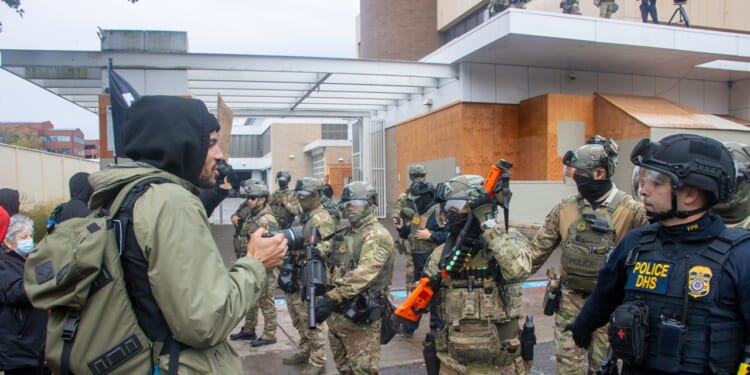It is unclear how long the deployment will last, or what its main objectives will be—aside from protecting government facilities from a handful of liberal protesters in frog costumes.
A ruling by the Ninth Circuit Court of Appeals this week—overturning an injunction against the Trump administration’s plan to deploy National Guard troops within Oregon—apparently clears the way for the deployment of the Oregon National Guard to Portland over the state’s own objections. The ruling reversed Judge Karen Immergut’s earlier decision, which held that Trump’s claim of an “emergency” was not consistent with the facts on the ground. It effectively authorizes a federally-directed military presence in a city that, until now, had remained relatively tame in its anti-ICE protests.
Granted, Portland has had a recent history of persistent—and sometimes violent—protests, notably during the summer of 2020. But five years have passed, and skeptics have argued that the city’s current situation hardly warrants a deployment that will likely look less like a police reinforcement and more like a scaled-down military occupation.
What the National Guard Is Bringing to Portland
The force composition, logistics footprint, and hardware potentially associated with the type of deployment described could be significant—enough for deterrence and crowd control, rather than community reassurance.
A typical urban deployment of this kind will likely involve a battalion-sized element, numbering from 400 to 800 personnel, drawn from the 41st Infantry Brigade Combat Team, the primary element of Oregon’s Army National Guard. The formation will likely include three or four infantry or military police companies, a command and control headquarters, a quick-reaction force, and small detachments for aviation, logistics, and medical support.
One can expect National Guard troops to wear standard combat uniforms and Interceptor or IOTV body armor, with ballistic helmets, gloves, goggles, and gas masks. Each soldier will typically be armed with an M4 carbine or M17 sidearms—though live ammunition should be highly controlled. Instead, troops will likely be armed with an assortment of defensive and less-lethal options: riot shields, batons, pepper spray, and 40-mm less-lethal launchers capable of firing foam, rubber, or OC-filled projectiles. Tear-gas grenades and “flash-bang” grenades, standard crowd-dispersal tools, are also likely to be distributed.
Army vehicles are also likely to be present in significant numbers. The National Guard routinely employs Humvees and Light Medium Tactical Vehicles (LMTVs) for troop and supply movement. Some of the vehicles may be up-armored, equipped with mounted lights, cameras, or public-address systems. Heavier vehicles could also be deployed, like the M1117 Armored Security Vehicle or MRAP—which would likely be positioned around federal buildings or convoy routes to signal control and provide ballistic protection.
And a small aviation detachment will deploy; likely a few UH-60 Black Hawks or UH-72 Lakotas, which will be used for aerial observation, transport, or medieval. The aircraft also serve a psychological purpose—a very loud, and hard to miss, reminder from above that the Army is in town.
The Logistics of a National Guard Deployment
To support the deployment, there will likely be behind-the-scenes architecture including mobile command posts, satellite communication shelters, generators, and field kitchens. Staging areas are typically established at existing Guard facilities, airports, or convention-center-style parking lots. Once the support architecture is in place, troops can sustain operations for weeks.
It is unclear how long the National Guard deployment will last, or what its main objectives will be—aside from protecting government facilities from a handful of liberal protesters in frog costumes. If the deployment to Portland ends up resembling the similar deployment to DC, National Guardsmen will likely spend the better part of their time pursuing miscellaneous tasks such as garbage cleanup.
The controversy around the deployment of National Guard troops in a state over the objections of that state’s own government will likely continue to grow. In a certain sense, it is ironic that a Republican administration, whose constituents have loudly decried “federal overreach” on many previous occasions, would launch such a deployment instead of a Democratic one.
For Portlanders now, the key will be to avoid taking the administration’s bait—remaining peaceful and avoiding signaling in any way that the deployment was justified.
About the Author: Harrison Kass
Harrison Kass is a senior defense and national security writer at The National Interest. Kass is an attorney and former political candidate who joined the US Air Force as a pilot trainee before being medically discharged. He focuses on military strategy, aerospace, and global security affairs. He holds a JD from the University of Oregon and a master’s in Global Journalism and International Relations from NYU.
Image: Shutterstock / CitizenKepler.


















